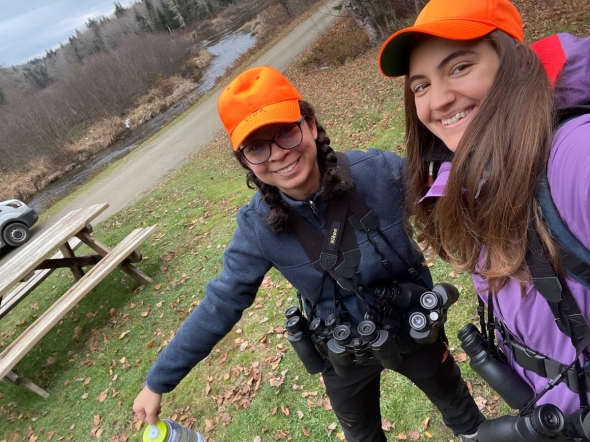

Kalina Duncheva


DOC Trip Leaders and How You Can Become One
DOC stands for Dartmouth Outing Club–a large club with many sub clubs dedicated to the outdoors. The DOC is "the oldest and largest collegiate outing club" in the US (you can read more about it here). The DOC organizes nature-centered trips with a focus on different activities every single day. There are ice-climbing trips, birdwatching trips, canoeing trips, and skiing trips.
But who leads these trips? That's what I am about to tell you.
This week I attended a Flora and Fauna seminar (FnF is a sub club of the DOC that focuses on birding and nature walks) for leaders in training, or saplings to use some FnF jargon. While I'm not planning yet to be a trip leader, many freshmen are already halfway through all of the requirements to lead a trip and will pretty soon be actual DOC leaders.
What exactly is the job of a DOC trip leader?
Trip leaders organize trips, put them up on Trailhead, where other students can sign up for trips, and actually take other students (called trippees) out on adventures. If you are a CnT leader (Cabin and Trail), you'll probably lead a lot of backpacking trips. If you're an FnF leader (Flora and Fauna), you might lead some tree ID trips. If you are a Winter Sports leader, you might lead a backcountry skiing trip to the Dartmouth Skiway. Trip leaders can also get van certified (i.e. you can drive one of the DOC vans, so you can take your trippees somewhere cool - header image shows trip leaders Ian and Levi, Ian is van-certified). They are also responsible for taking care of everyone's dietary needs, so when they're buying food, they have to look on Trailhead everybody's allergies and make sure everyone will have lunch.
When you first come to Dartmouth and join the DOC, you'll meet a lot of trip leaders. If you go to club meetings (as you should!), you'll also hear these leaders announce the trips they're leading out that given week. The first few weeks it's exciting, and you have no idea how these trip leaders manage to organize such adventures. By the end of your first fall or winter term, though, you start peeking behind the curtain and understand that it's not rocket science–and you can, too, become a trip leader.

So how do you become a trip leader?
Well, you need to attend a few seminars on group dynamics and risk management among other topics. You have to get a WFA (wilderness first aid) certificate or even a WFR (wilderness first responder) certification. If you are a Winter Sports leader, you might need to get AIARE certified (avalanche safety). The best thing is that all of these courses are subsidized by the Outdoors Programs Office.
Apart from all of these certifications, you also need to co-lead a few trips, so you learn from current leaders how to set up your trip on Trailhead, how to make sure everyone is safe and happy on your trip, and in general, how to embody the DOC's values in the outdoors.
There will also be other qualifications (like can you light a fire), but these depend on the specific club in which you want to be a leader.
Posts You Might Like

New Hampshire is such a glorious state with so much to offer in the fall! Come with me as I explore Plainfield, NH, and go apple picking at Riverview Farms.


Hear about the start of my sophomore year!


Now that I'm a sophomore, I find myself in the possession of an extraordinary amount of 'Dartmouth lingo.' This is your formal invitation to get the inside scoop!


Now that I'm officially halfway through my Dartmouth career, I'm acutely aware of how fast time seems to fly. It seems like years ago that I first experienced Fallapalooza, a free concert for Dartmouth students hosted by Programming Board.


Sunrikes, sunsikes, sophomore summer, and sleep. What are these words and what do they have to do with each other?!?!



Here's a list of some things I'm looking forward to this fall!


This blog post is dedicated to my mom, the heart of who I am today—and my time at Dartmouth.


Read on to learn about the Dartmouth Outing Club's Surf Club and my adventure to the Atlantic.

